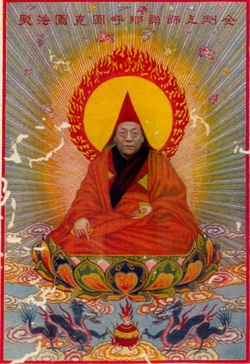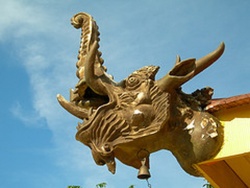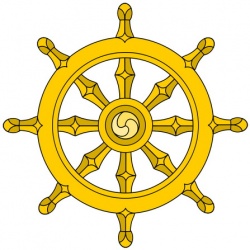Gara Lama Sonam Rabten
Gara Lama Sonam Rabten (mgar ra bla ma bsod nams rab brtan) was born in 1865 (or possibly 1876) near Riwoche. His family belonged to the Gar Tatsang clan (mgar ra tsang) which claimed descent from the seventh century King Songten Gampo's (srong btsan sgam po) minister Gar Songtsan (mgar srong rtsan). He was given the birth name of Sonam Rabten. His ordination name was Trinle Gyatso ('phrin las rgya mtsho).
Gara Lama received instruction from his elder brother, the Seventh Riwoche Jedrung, Jampa Jungne (ri bo che rje drung 07 byams pa'i 'byung gnas, 1856-1922), studying at Riwoche's Nyingma Dratsang (rnying ma rwa tshang), excelling in painting as well as scholarship. He also studied with Riwoche Drubtob Chenpo (ri bo che grub thob chen po), the head of the monastery. Gara Lama lived with this master for several years at a hermitage about twenty-five miles from Riwoche called Wenne Gurulung (dben gnas gu ru lung), where he received empowerments and transmissions in both Nyingma and Taklung Kagyu traditions, including both Dzogchen and Mahāmudrā.
When his elder brother Jampa Jungne was made abbot of Riwoche, he asked Gara Lama to take charge of the secular affairs of the lands controlled by the monastery and branch monasteries, forcing him to leave retreat and enter into political affairs.
Jampa Jungne, an accomplished treasure revealer, is said to have predicted that Gara Lama would reveal a treasure at a lake in Pome, Kanam Lhatso (ka gnam lha mtsho) to the southeast of Riwoche, and led a large crowd there.
Arriving at the lake, Gara Lama walked into the water, holding a lit butter lamp, until he was completely submerged. When he emerged moments later, the lamp still lit, he carried a small turquoise box. He handed the small box to his elder brother, out of which came a text for the practice of Vajrakila and medicinal substances for the treatment of leprosy.
Following this event, the two brothers led a group of refugees to Pome in the wake of the Qing general Zhao Erfeng's (1845-1911) invasion of Kham and his attack on Riwoche.
Jampa Jungne intended to reveal further realms of the mythical hidden land of Pemako (pad+ma bkod) and the group settled first on the north side, and then next on the south side of the Himalaya, settling in a region called Miphi and establishing a small temple there, Karmo Ling (dkar mo gling).
Gara Lama and Jampa Jungne returned to Riwoche in 1910 or 1911, right as the dying Qing Empire made one last attempt to conquer Tibet. Zhao Erfeng again marched through Kham, this time on his way to Lhasa, arriving in 1910.
When the Qing collapsed in 1911, however, the Chinese were expelled from Tibet and retreating armies passed through Riwoche, adding to a garrison that had been based there for some time. In 1917, when Chinese troops attempted to take control of the Chamdo region, Chinese soldiers threatened to burn the monastery and Gara Lama mediated with the Chinese commander, General Peng Risheng, succeeding in saving the temple (which was promptly sacked by the Tibetan army). When the Ganden Podrang took control of Riwoche, both Gara Lama and his elder brother were suspected by the Tibetans of being Chinese agents.
Gara Lama was arrested and brought to Lodrak, and the Jedrung was taken to Drigung, where he was allowed to teach but remained under suspicion.
After two years of a life-sentence, Gara Lama escaped, fleeing first to Nepal and then Shanghai, arriving in Beijing in 1924.
He tried but was unsuccessful in gaining support for retaking Riwoche from the Tibetans. He did teach the president of China, [Duan Qirui] (1865-1936) in the early 1920s, but althought Duan gave permission to return to Kham, he did not supply the means to drive the Tibetans out.
When Duan was driven from office by the warlords who had placed him there, Gara Lama went to Chongqing at the invitation of a warlord there, Liu Xiang, who appears to have been a sincere Buddhist practitioner interested in the Nyingma tradition.
Gara Lama even established a small Buddhist center in Chongqing, called the Shijie Fojiao Datong Hui, the Harmonious Association for World Buddhism, where he taught dharma, published scripture, and even engaged in charitable acts modeled perhaps on the Christian missionaries.
Gara Lama was thus one of the first Tibetan lamas to translate Tibetan Buddhist traditions and teachings into a modern Chinese idiom for the general population. He was said to have attracted upwards of ten thousand disciples for some of the larger assemblies, such as a semi-annual 100-day prayer festivals.
In 1929 Gara Lama was summoned back to Beijing by the Guomindang government, which made him a member of the new Mongolian and Tibetan Affairs Commission. Gara Lama was given three offices, in Chongqing, Chengdu, and Kangding (Dartsedo), essentially establishing him as the Nationalist Government's agent for Kham east of the Yangtze. Gara Lama also served on Nationalist Buddhist committees, including the Chinese Buddhist Studies Association and the Chinese Bodhi Studies Association, and engaged in ritual services designed to avert disaster and bring well-being to the nation. By 1930 he had become a national figure, giving public teachings and ritual services across the country.
In 1935 Gara Lama was also made a member of the commission charged with the creation of the short-lived province of Xikang, given the title Xikang Xuanweishi, or Xikang Pacification Commissioner, largely to mobilize against Red Army forced in Kham. However, it seems Gara Lama did not fully support the existence of Xikang province – an administrative district that never managed to succeed. It seems that Gara Lama worked in secret to create two separate provinces, one based in Kangding, the other in Chamdo. The second, in Chamdo, would have included his own Riwoche Monastery, and it appears that he had hopes to be made governor of this province.
In Dartsedo Gara Lama stoked resentment against the nominal governor, Liu Wenhui, and raised an army to overthrow him. In September Gara Lama proclaimed Kham self-rule and ordered Lui's troops out of Kham.
Gara Lama gained the support of a Chinese commander, General Li Baobing, who was in Kham to fight the Communists and who despised Liu. But Gara Lama was twice defeated by the Communists, first in Tau (rta'u) and again in Drango (brag 'go), and was finally captured by a Tibetan Communist named Pelden Dorje (dpal ldan rdo rje). He passed away in a Communist prison in 1936, at the age of seventy-three.
Sources
Goldstein, Melvyn, Dawei Sherap, and William Siebenschuh. 2004. A Tibetan Revolutionary: The Political Life and Times of Bapa Phüntso Wangye. Berkeley: University of California Press, p. 15.
McLennan, Pelden. n.d. “Realization in Action: The Life of Gara Lama Nora Rinpoche.” Unpublished paper.
Peng Wenbin. “Frontier Process, Provincial Politics and Movements for Khampa Autonomy During the Republican Period.” In Kham-pa Histories. Lawrence Epstein, ed., pp. 57-84. Leiden: Brill, pp. 68-71.
Rje drung 'jam pel rgyal mtshan. 1985. Ri bo che dgon pa dang rje drung sprul sku mga ra ra bla ma bcas kyi lo rgyus rags bsdus. In Bod kyi rig gnas lo rgyus dpyad gzhi'i rgyu cha bdams bsgrigs, 'don thengs drug pa. Lhasa: Bod ljongs chab gros rig gnas lo rgyud dpyad gzhi'i rgyud cha zhib 'jug u yon lhan khang.
Skal bzang bkra shis. 1996. Mgar ra bla mas lu'u cun dmag khams khul 'byor skabs mnyam 'brel dang go min tang skabs bod sog u yon lhan khang gi u yon sogs byas skor. In Bod kyi lo rgyus rig gnas dpyad gzhi'i rgyu cha bdams bsgrigs, vol. 10 (19), pp. 113-122. Beijing: mi rigs dpe skrun khang.
Tuttle, Gray. 2005. Tibetan Buddhists in the Making of Modern China. New York: Columbia University Press.
Alexander Gardner December 2009


